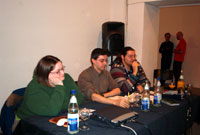|
Hacktivism: Was tun?/Che fare?

Panel: Hacktivism: Was tun/Che fare? -8th February 2005, Kunstraum Kreuzberg/Bethanien, Berlin, D
[Panels Fotos]
Italien ist ein Land der Extreme. Einerseits die autokratische Herrschaft Berlusconis, der sowohl die italienische als auch die europäische Politik manipuliert und über die mehr oder weniger komplette Kontrolle der Massenmedien verfügt. Auf der anderen Seite eine große Zahl von Intellektuellen und Aktivisten, die sich gegen die Regierung aussprechen.
Die Demonstrationen in Genua 2001, bei denen Millionen von Menschen gegen den Krieg im Irak protestierten und die darauf folgenden Generalstreiks sind nur die Spitze des Eisbergs. Während die institutionelle Politik Italiens als rigides festgefahrenes System erscheint, hat sich in den vergangenen zehn Jahren eine international vernetzte Szene und enorm heterogene Gegenkulturen entwickelt. Dieses Netzwerk organisiert gesellschaftliche Intervention und Demonstrationen und ist für seine Vielzahl von Medieninitiativen bekannt. Es arbeitet mit verschiedenen Mitteln bei der Verbreitung seiner Inhalte: Radio, Streaming von Videos im Netz, Mailinglisten, lokalen TV Stationen, Websites. Oft betrifft der Inhalt nicht nur politische Themen, sondern befasst sich auch mit Themen, die in Bezug auf Netzkultur und Neue Medien relevant sind, so zum Beispiel die Frage nach Urheberrecht und freien Netzwerken.
Das Panel 'Hacktivism: Was tun/Che fare?' verbindet Theoretiker und Aktivisten aus Italien und Deutschland, es reflektiert das Konzept Hacktivism und dessen Zukunft nach 20 Jahren unabhängiger Aktivität auf diesem Gebiet. Auf welchem Stand ist Hacktivism heute? Welche Gemeinsamkeiten und Unterschiede gibt es zwischen einem italienischen Verständnis des Hacktivism und einer international verbreiteten Auffassung des Begriffs?
Die frühen Netzutopien sind vorbei. Ist Hacktivism noch möglich, auch wenn der Cyberspace von ökonomischen Interessen dominiert wird? Ist es noch möglich, radikale unabhängige Information und künstlerischen Ausdruck im Netz zu verbreiten? Sind Netzcommunities noch immer Plattformen der nicht-hierarchischen Organisation?
Hacktivism: Was tun/Che fare? - 8. Februar 2005, 19.00 Uhr
- Erster Teil (19.00 Uhr):
- Sebastian Lütgert, Textz.com www.textz.com (Berlin, D)
- Tommaso Tozzi, Hacker Art www.hackerart.org (Florenz, IT)
- Zweiter Teil (20.00 Uhr):
- Susanne Schmidt, www.informationsfreiheiten.de (Berlin, D)
- Asbesto, Freaknet Medialab, www.freaknet.org (Catania, IT)
- Diskussion (21.00 Uhr)
- Moderation: Alessandro Ludovico, Neural www.neural.it (Bari, IT)
[Panels Fotos]
Sebastian Lütgert – Textz.com – Bootlab (Berlin, D)
Lives in Berlin, working as a writer, programmer and artist. Recent projects include magazines (The German Issue, Starship, Auseinander), websites (germany.kz, textz.com, rolux.org), videos (Burn Hollywood Burn, Betacity, The Coils of the Serpent) and others. Group exhibitions (selection): Werkleitz Biennale (Halle), Kuenstlerhaus (Wien), Galerija VN (Zagreb), Transmediale (Berlin), Kunsthalle Exnergasse (Wien), Kunstwerke (Berlin), Cinematexas (Austin), PS1 (New York), ZKM (Karlsruhe). He is a co-founder of Bootlab (Berlin).
www.textz.com - www.bootlab.org
Tommaso Tozzi – hacker art (Florence, Italy)
Tommaso Tozzi (1960) is probably one of the first Italian artists who worked since early Nineties only on new media and the net. Rather than building installations or objects, the artist exploits new media as instruments of communication, creating spaces for discussion and meeting places. Before getting wired, Tozzi had developed a magazine transmitted by fax, an artzine only readable through BBS and an art magazine that was posted on walls. He was co-founder of the artistic group Strano Network in 1993 (Florence) and works as a Professor in the Department of Mass Media in Accademia di Belle Arti of Carrara. He was the founder of Hacker Art BBS (1990), the first artistic network in Italy and creator of the first Netstrike in the world (1995). Publications: Hacktivism. La libertà nelle maglie della rete, ManifestoLibri, 2002; with Strano Network: Nubi all'orizzonte (1996), Net Strike, no copyright, etc.- Pratiche antagoniste nell'era telematica (1996). He also work with the collective Isole Nella Rete.
www.hackerart.org - www.strano.net/tozzi.htm
Susanne Schmidt – Informationsfreiheiten.de (Berlin, D)
Susanne Schmidt studied political science in Berlin and changed suddenly her profession from science to technology in 1993, fascinated by the upcoming possibilities of the Internet and Linux. Since 1993 she works as a freelancing journalist, projectmanager and sometimes as
a software developer exclusively in Linux/Open Source environments. Main interests are natural language processing, freedom of information, possiblities of translating techniques of investigative journalism into technology and transporting technology into political activism, the development of Perl 6, women and hacking and modern japanese art.
www.informationsfreiheiten.de
Gabriele 'Asbesto' Zaverio – Freaknet Medialab (Catania, Italy)
On the net since early 80s, he is co-founder of Freaknet Medialab, freaknet.org and Radio Cybernet. Freaknet Medialab is an Italian hacklab which provides access for everybody through old assembled computers. Freaknet is lead by a committee of hackers sharing their researches in solidarity to achieve common goals: for the knowledge, for the freedom of speech, for an aesthetic vocation, for a sustainable model in free software development, for a better sharing of free technologies and informations among who has less opportunities to access them.
www.freaknet.org - http://poetry.freaknet.org - Personal website: www.zaverio.net
www.hackmeeting.org (Italian hackers community website)
Moderation: Alessandro Ludovico – Neural magazine (Bari, Italy)
Since 1993 Alessandro Ludovico is the editor-in-chief of Neural, the Italian new media culture magazine. In 2000 he edited ‘Suoni Futuri Digitali’ (Future Digital Sounds), an in-depth research that chronicles the history of the innovations that have drastically changed how we produce and experience sounds. He’s one of the founding members of the Nettime list, and one of the founding member of the ‘European Peripheral Magazine list’. In 2001 he joined the n.a.m.e. (normal audio media environment) art group and developed ‘Sonic Genoma’, a computer art installation. He's also in charge of "Neural Station", a weekly radio show on electronic music and digital culture, and is the publisher of daily updates on the Neural website.
www.neural.it
Hack.it.art info
AHA Home
|





